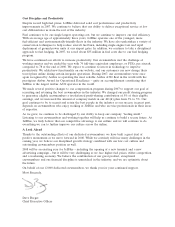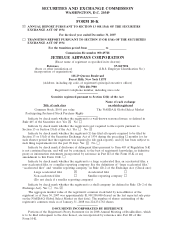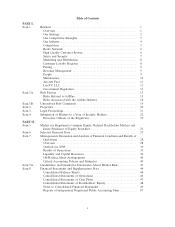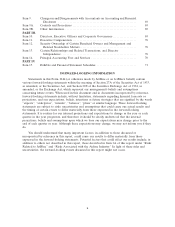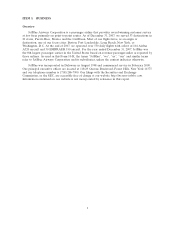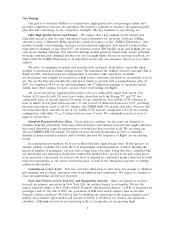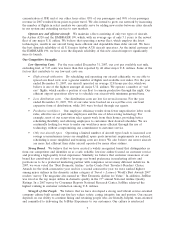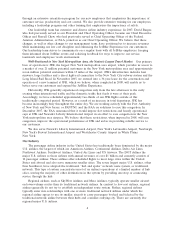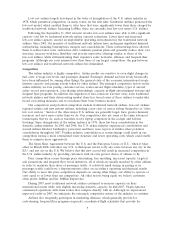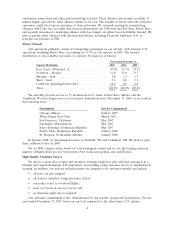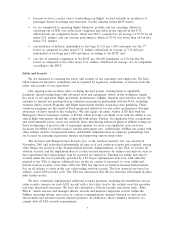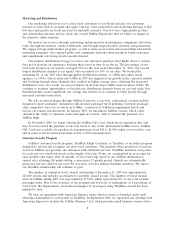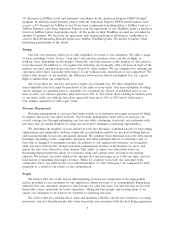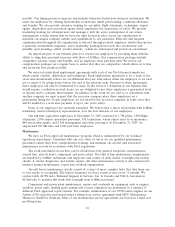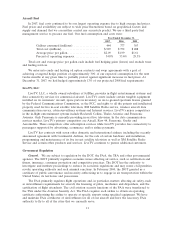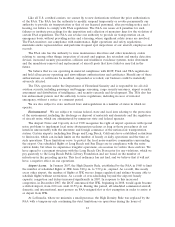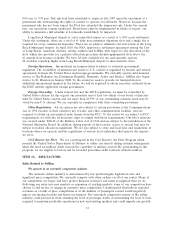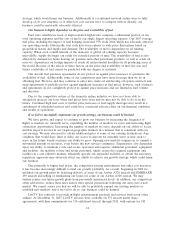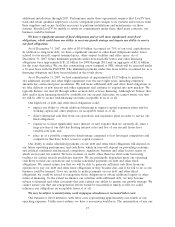JetBlue Airlines 2007 Annual Report Download - page 15
Download and view the complete annual report
Please find page 15 of the 2007 JetBlue Airlines annual report below. You can navigate through the pages in the report by either clicking on the pages listed below, or by using the keyword search tool below to find specific information within the annual report.Low-cost airlines largely developed in the wake of deregulation of the U.S. airline industry in
1978, which permitted competition on many routes for the first time. Southwest Airlines pioneered the
low-cost model, which enabled them to offer fares that were significantly lower than those charged by
traditional network airlines. Including JetBlue, there are currently four low-cost major U.S. airlines.
Following the September 11, 2001 terrorist attacks, low-cost airlines were able to fill a significant
capacity void left by traditional network airline capacity reductions. Lower fares and increased
low-cost airline capacity created an unprofitable operating environment for the traditional network
airlines. Since 2001, the majority of traditional network airlines have undergone significant financial
restructuring, including bankruptcies, mergers and consolidations. These restructurings have allowed
them to reduce labor costs, restructure debt, terminate pension plans and generally reduce their cost
structure, increase workforce flexibility and provide innovative offerings similar to those of the
low-cost airlines, while still maintaining their expansive route networks, alliances and frequent flier
programs. Although our costs remain lower than those of our largest competitors, the gap between
low-cost airlines and traditional network airlines has diminished.
Competition
The airline industry is highly competitive. Airline profits are sensitive to even slight changes in
fuel costs, average fare levels and passenger demand. Passenger demand and fare levels historically
have been influenced by, among other things, the general state of the economy, international events,
industry capacity and pricing actions taken by other airlines. The principal competitive factors in the
airline industry are fare pricing, customer service, routes served, flight schedules, types of aircraft,
safety record and reputation, code-sharing relationships, capacity, in-flight entertainment systems and
frequent flyer programs. In addition, the migration of fare-conscious travelers away from traditional
network airlines and their deteriorating market share has forced some of these airlines to undertake
broad cost-cutting measures and to reevaluate their basic business models.
Our competitors and potential competitors include traditional network airlines, low-cost airlines,
regional airlines and new entrant airlines, including a new class of carrier styling themselves as ‘‘ultra
low cost carriers.’’ Seven of the other major U.S. airlines are generally larger, have greater financial
resources and serve more routes than we do. Our competitors also use some of the same advanced
technologies that we do, such as ticketless travel, laptop computers in the cockpit and website
bookings. Since deregulation of the airline industry in 1978, there has been consolidation in the
domestic airline industry. In 2005 and 2006, the U.S. airline industry experienced consolidation and
several airlines filed for bankruptcy protection and there were reports of further other potential
consolidation throughout 2007. Further industry consolidation or restructurings could result in our
competitors having a more rationalized route structure and lower operating costs, which could enable
them to compete more aggressively.
The Open Skies Agreement between the U.S. and the European Union, or E.U., when it takes
effect in March 2008, will allow any U.S. or European carrier to fly any route between any city in the
E.U. and any city in the U.S. We believe that this new accord will result in increased competition in
the U.S. airline industry by providing customers with an even greater choice of airlines to fly.
Price competition occurs through price discounting, fare matching, increased capacity, targeted
sale promotions and frequent flyer travel initiatives, all of which are usually matched by other airlines
in order to maintain their share of passenger traffic. A relatively small change in pricing or in
passenger traffic could have a disproportionate effect on an airline’s operating and financial results.
Our ability to meet this price competition depends on, among other things, our ability to operate at
costs equal to or lower than our competitors. All other factors being equal, we believe customers
often prefer JetBlue and the JetBlue Experience.
During 2007, most traditional network airlines continued to increase capacity on their
international routes while only slightly increasing domestic capacity. In mid-2007, Virgin America
commenced operations with some routes that compete directly with us. Although we experienced
improved yields in 2007, we anticipate the extremely competitive nature of the industry to continue.
Airlines also frequently participate in marketing alliances, which generally provide for
code-sharing, frequent flyer program reciprocity, coordinated flight schedules that provide for
5


